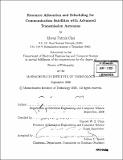| dc.contributor.advisor | Vincent W.S. Chan. | en_US |
| dc.contributor.author | Choi, Jihwan Patrick, 1975- | en_US |
| dc.contributor.other | Massachusetts Institute of Technology. Dept. of Electrical Engineering and Computer Science. | en_US |
| dc.date.accessioned | 2007-08-03T18:27:24Z | |
| dc.date.available | 2007-08-03T18:27:24Z | |
| dc.date.copyright | 2006 | en_US |
| dc.date.issued | 2006 | en_US |
| dc.identifier.uri | http://hdl.handle.net/1721.1/38298 | |
| dc.description | Thesis (Ph. D.)--Massachusetts Institute of Technology, Dept. of Electrical Engineering and Computer Science, 2006. | en_US |
| dc.description | Includes bibliographical references (p. 175-180). | en_US |
| dc.description.abstract | For multimedia and other data services over satellite networks, the efficient management of scarce satellite communication resources is critical for the economic competitiveness of the medium. To support a broad spectrum of users with small terminals at high data rates, narrow transmit spotbeams from the satellite must be used. Since satellite on-board resources are too expensive to illuminate all of the spotbeam-coverage cells within the satellite service area, an optimized method of agile antenna gain patterning and beam scheduling is required to greatly improve the efficiency of transmission and power management. In this thesis, we jointly optimize resource allocation/scheduling, congestion control and antenna gain patterning for communication satellites with advanced transmission antennas. Then, we develop a low-complexity on-line algorithm that considers channel conditions, interference and average delay constraints, and approaches the theoretical steady-state limit. We introduce optimized beam profiling based on traffic demand and channel conditions over satellite downlinks, which can achieve a substantial power gain and reasonable proportional fairness. We show that a modest number of active parallel beams are sufficient to cover many cells efficiently with dynamic capacity allocation. | en_US |
| dc.description.abstract | (cont.) Next, for the multiple beam antenna case, we develop a jointly optimized scheme of beam allocation and congestion control with transmitter-sharing and average delay constraints, which provides high throughput and/or small average queueing delays. Last, we find the solution for joint antenna gain patterning and scheduling by considering spatially close co-channel interference in the use of phased array antenna. We suggest an optimum scheduling policy, which selects users with higher marginal returns of a composite cost function with respect to allocated power, in terms of better channel conditions, less interference (depending on users' geographic distribution), and larger delay. The simulation result indicates that a real-time on-line algorithm can achieve a throughput close to the analytic steady-state upper bound. Due to its flexible power allocation, we demonstrate that the phased array antenna can provide better performance than the multiple beam antenna when a small number of users are very demanding or many users are located in a small and crowded area | en_US |
| dc.description.statementofresponsibility | by Jihwan Patrick Choi. | en_US |
| dc.format.extent | 180 p. | en_US |
| dc.language.iso | eng | en_US |
| dc.publisher | Massachusetts Institute of Technology | en_US |
| dc.rights | M.I.T. theses are protected by copyright. They may be viewed from this source for any purpose, but reproduction or distribution in any format is prohibited without written permission. See provided URL for inquiries about permission. | en_US |
| dc.rights.uri | http://dspace.mit.edu/handle/1721.1/7582 | |
| dc.subject | Electrical Engineering and Computer Science. | en_US |
| dc.title | Resource allocation and scheduling for communication satellites with advanced transmission antennas | en_US |
| dc.type | Thesis | en_US |
| dc.description.degree | Ph.D. | en_US |
| dc.contributor.department | Massachusetts Institute of Technology. Department of Electrical Engineering and Computer Science | |
| dc.identifier.oclc | 153917310 | en_US |
